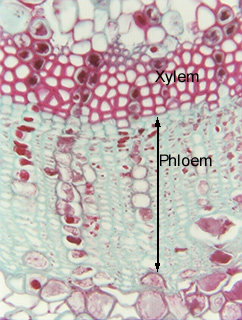 Fig.
16.1-5a and b. Transverse sections of
conifer needles. Most conifers have needle-shaped or scale-like leaves that
remain alive for years, but their sieve cells last only a few months. These
long-lived leaves have a vascular cambium that produces new secondary phloem
every year. But the cambium does not produce any more xylem: it is a
unifacial, unidirectional, persistent vascular cambium. The upper micrograph shows the secondary phloem in the needle leaf of pine (Pinus monophylla)
and the lower one is a leaf of yew (Taxus). Long-lived leaves of
dicots can also have secondary phloem along the midrib and larger veins. See
pages 254, 255 and Fig. 12.35 in Plant Anatomy (Mauseth).
Fig.
16.1-5a and b. Transverse sections of
conifer needles. Most conifers have needle-shaped or scale-like leaves that
remain alive for years, but their sieve cells last only a few months. These
long-lived leaves have a vascular cambium that produces new secondary phloem
every year. But the cambium does not produce any more xylem: it is a
unifacial, unidirectional, persistent vascular cambium. The upper micrograph shows the secondary phloem in the needle leaf of pine (Pinus monophylla)
and the lower one is a leaf of yew (Taxus). Long-lived leaves of
dicots can also have secondary phloem along the midrib and larger veins. See
pages 254, 255 and Fig. 12.35 in Plant Anatomy (Mauseth).
Only
larch (Larix), bald cypress (Taxodium) and dawn redwood (Metasequoia)
are deciduous, with leaves that persist for less than a year).